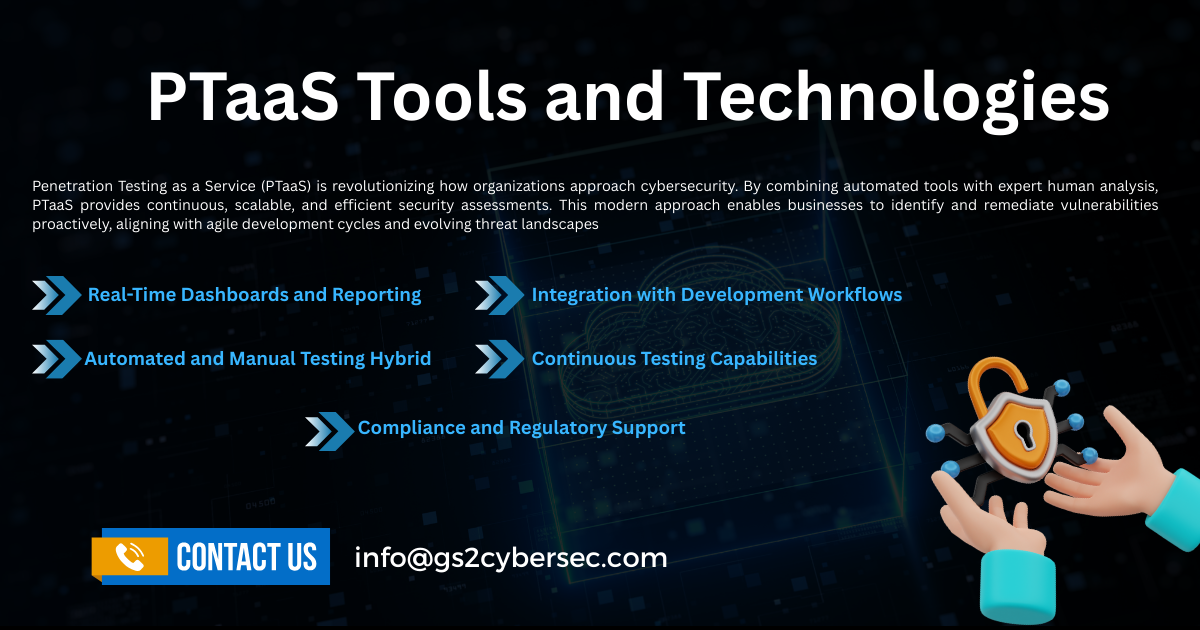
PTaaS Tools and Technologies: An Overview of Popular Solutions
PTaaS offers a modern approach to penetration testing by combining automated tools with the expertise of security professionals. This allows organizations to continuously assess their digital infrastructure for vulnerabilities. As a result, businesses can stay ahead of potential cyberattacks and protect sensitive data, all while optimizing their security workflows. This blog will dive into PTaaS, exploring its key features, benefits, and the best solutions available in the market. Whether you a

Overview
of PTaaS
Penetration Testing as a Service (PTaaS) is a cybersecurity
solution that provides ongoing, on-demand penetration testing through a
combination of automated tools and human expertise. Unlike traditional
penetration testing, which is typically performed on a fixed schedule, PTaaS
offers real-time security assessments, enabling businesses to identify and
address vulnerabilities as they emerge. PTaaS integrate into an organization’s
existing workflows, ensuring seamless vulnerability detection across applications,
networks, and other digital assets. With PTaaS, businesses gain continuous
visibility into their security posture, allowing them to address potential
threats before they can cause harm.
Key Features of PTaaS Tools
PTaaS tools come equipped with a variety of features that
make them essential for maintaining a strong cybersecurity posture. Key
features of these tools include:
● Continuous Testing: PTaaS solutions allow for
continuous testing, offering organizations the flexibility to conduct
assessments whenever necessary, without being restricted to fixed schedules.
● Automated and Manual Testing: By combining automated
vulnerability scans with expert human testing, PTaaS tools ensure comprehensive
vulnerability detection and accurate results.
● Real-Time Insights and Reporting: With PTaaS, organizations gain
real-time visibility into their vulnerabilities, enabling them to respond
quickly to threats.
● Seamless Integration: PTaaS tools can be easily
integrated into an organization’s development lifecycle, ensuring early
detection and quick remediation of vulnerabilities.
● Actionable Remediation Guidance: PTaaS platforms provide detailed
reports and recommendations, helping organizations address identified
vulnerabilities in an efficient and systematic manner.
These features ensure that businesses can proactively defend
against cyber threats and enhance their overall security posture.
How PTaaS Tools Enhance
Cybersecurity?
PTaaS tools provide numerous benefits that help businesses
enhance their cybersecurity defenses. By offering continuous and proactive
testing, PTaaS solutions reduce the risk of successful cyberattacks. Here’s how
PTaaS tools improve cybersecurity:
● Proactive Risk Identification: Unlike traditional testing methods,
PTaaS allows organizations to identify vulnerabilities as soon as they emerge,
reducing the likelihood of exploitation.
● Faster Response Times: Real-time reporting and actionable
insights enable businesses to quickly address vulnerabilities before attackers
can exploit them.
● Comprehensive Coverage: With both automated and
human-driven testing, PTaaS solutions ensure that a wide range of
vulnerabilities are identified, including those that may be missed by automated
scanners alone.
● Reduced Attack Surface: By continuously testing and
addressing vulnerabilities, businesses can effectively reduce their attack
surface, making it harder for cybercriminals to breach their systems.
By using PTaaS, businesses create a dynamic security posture
that evolves alongside emerging threats.
Integration with Existing Security Infrastructure
PTaaS tools are designed to integrate seamlessly with your
organization’s existing security infrastructure. Whether you use vulnerability
management systems, Security Information and Event Management (SIEM) tools, or
other security solutions, PTaaS platforms can work in tandem with these systems
to provide a unified view of your security posture. Integration is essential
for maintaining an efficient and effective security workflow. PTaaS tools, such
as Synack and Strobes Security, allow businesses to incorporate testing results
directly into their existing cybersecurity processes, enabling faster
vulnerability identification and remediation.
Cost-Effectiveness and Scalability
One of the most appealing aspects of PTaaS is its
cost-effectiveness compared to traditional penetration testing. PTaaS solutions
typically follow a subscription or pay-per-use model, meaning businesses only
pay for the services they need. This flexibility makes it easier for
organizations of all sizes to access high-quality security testing without
exceeding their budgets. Moreover, PTaaS tools are scalable, allowing
businesses to adjust the scope of testing as their needs evolve. Whether you’re
a small business or a large enterprise, PTaaS can be customized to fit your
unique security requirements.
Choosing the Right PTaaS Tool for Your Organization
When choosing a PTaaS solution, there are several factors to
consider, including your organization’s size, the complexity of your digital
infrastructure, and your security needs. Some key considerations include:
● Testing Capabilities: Ensure the solution offers
comprehensive testing for all your digital assets, including networks, web
applications, APIs, and more.
● Integration: Choose a PTaaS platform that easily integrates with your
existing security tools and workflows.
● Expertise: Look for a provider that combines automated scanning with
expert manual testing to ensure thorough vulnerability detection.
● Support and Reporting: Make sure the solution provides
detailed reports and expert guidance on vulnerability remediation.
By evaluating these factors, you can select the PTaaS tool
that best meets your organization’s needs and strengthens your cybersecurity
defenses.
Conclusion
Penetration Testing as a Service
(PTaaS) is a powerful tool for organizations seeking to stay ahead of cyber
threats. By combining automated scanning with expert human testing, PTaaS
offers continuous, real-time insights into vulnerabilities, helping businesses
address security issues before they can be exploited.
Adopting PTaaS allows businesses to
proactively manage their security posture, reducing the risk of data breaches
and ensuring robust protection against evolving threats. By investing in the
right PTaaS tool, organizations can confidently safeguard their digital assets
in today’s ever-changing cybersecurity landscape.